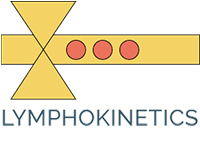Our team has performed numerous anatomical studies during these past thirty years, using human cadavers as well as live subjects in order to investigate the various trajectories of the lymphatic collectors (300 human cadavers for upper extremity AL1.32 ; for the head and neck OL1.2 ; for the lower limb (ref.)
We designed Manual Lymph Drainage after experimenting on live animals and healthy subjects(AL1.2, AL1.3, AL1.5, AL1.7, AL1.10 AL1.14, OL1.3, OL1.4, AL2.23).
We can summarize our technique as follows:
Lymph nodes drainage
Lymph nodes are emptied by simple pressure. It is not a stimulation because there is no contraction taking place in lymph nodes.
The maneuver on lymph nodes clears up these nodes before theye receive the lymph drained from the oedmatous area.
Call up inciting maneuver
This maneuver increases the frequency of contraction of smooth muscles of lymphangious of the lymphatic collectors of the area considered. This effect was related by lymphoscintigraphy (OL1.1, OL1. 3, OL1.4).
This technique generates also an acceleration of the drainage of the elements of lymphedema. This is the reason why we called it ” call up technique ” or inciting technique “.
Reabsorption maneuver
The technique of application of manual lymph drainage must be adapted to the specific pathology to be treated. The substitution pathways must be used only on patients who underwent a lymph nodes removal. In other cases, it is recommended to respect the classic anatomy considering some specific pathways which are not always described in anatomy but that we have discovered during our cadaveric dissections.
The relative duration of manual lymph drainage in a treatment may vary. For example, for a lower extremity edema, it may last from 15 to 20 minutes in case of edema post trauma, it may last one half hour for a congenital edema and 45 minutes for a lymphedema post oncologic surgery…
